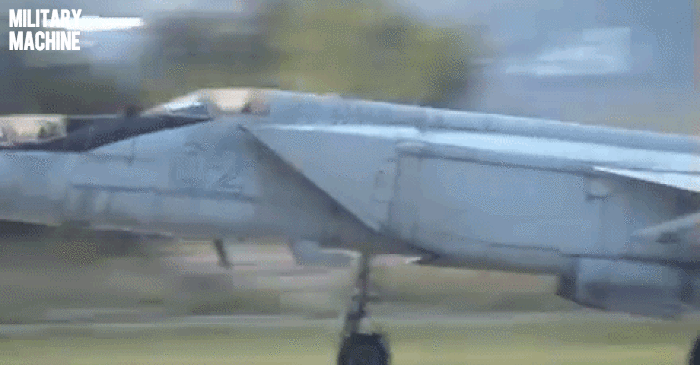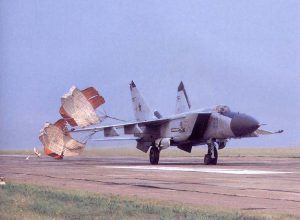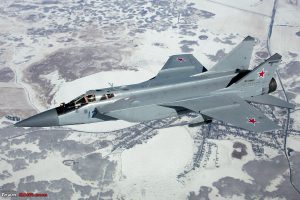The MiG-25 Soviet Fighter Aircraft
When the MiG-25 entered the air for the first time, it was in the middle of the Vietnam conflict and American strategists were worried a new Soviet fighter aircraft would soon become available to the North Vietnamese. The MiG-25, codenamed the “Foxbat” by NATO, was an incredibly fast twin engine interceptor that could reach speeds of up to Mach 2.83. Equipped with radar capabilities, it was not subject to the long range limitations of the MiG-21 and could out-compete existing American fighter jets in the sky.
Setting Records:
Thankfully, American forces never encountered a Foxbat in Vietnam. It did, however, encourage U.S. manufacturers such as McDonnell-Douglas to speed up their F-15 Eagle program. A long range interceptor of this caliber posed a significant threat to the nuclear deterrent capabilities of the United States. While the MiG-25 broke speed records and even achieved limited Mach 3, it was never used actively by the Soviet Union in any air campaign. A reconnaissance model of the aircraft was used in the Yom Kippur war of 1973. It flew reconnaissance missions over Israel and it could not be intercepted by Israeli F-4E’s. At one time, it was tracked at flying at speeds hovering around Mach 3.2.

Fastest Combat Aircraft:
This made it the second fastest flying jet outside of the SR-71 Blackbird. If ever there was free advertising for the capabilities of this aircraft, it was certainly made clear during the Yom Kippur war. This spurred large quantities to be sold to foreign air forces such as Saddam Hussein’s Iraqi Air Force and, in limited quantity to India and Egypt.

The Iran-Iraq War:
During the height of the Iran-Iraq war in the early 1980’s, the MiG-25 distinguished itself against Iranian F-4 Phantoms. The Phantoms were purchased under a trade agreement from the United States and were not at all equipped to handle the MiG-25’s long range missile capabilities or its close quarters dogfighting. Up until Iran deployed F-14 Tomcats, nothing in their fleet could stand up to Iraq’s MiG-25 fleet. These aircraft were used extensively to run reconnaissance and attack Iranian air support on an at-will basis.

Counters:
The F-14 Tomcat proved to be the only aircraft that could approach the MiG-25 Foxbat — and this was in large part to advancements in electronic warfare to disrupt the Foxbat’s long range targeting. Once within close range maneuvering distance, the F-14 could match the MiG-25. So much so that Iran was able to score 10 MiG-25 hits towards the end of the war. Only three MiG-25’s were taken down due to ground fire.
The F-15 Eagle Vs The Foxbat:
Now that we’ve established that the Foxbat is one of the fastest jets in the air, let’s deal with a sober point of reality. Speed is only one factor in air supremacy. By the early 1990’s, electronic warfare — to include jamming and evasion — had advanced a considerable deal by this point.
Gulf War:
American fighter pilots, confident in their array of fourth generation F/A-18 Hornets, F-16 Fighting Falcons, F-14 Tomcats, and F-15 Eagles, did little to plan or counter for their initial run-ins with the Iraqi Air Force. For the most part, the Iraqi Air Force was consigned to a hodge-podge smattering of borrowed, leased, and bought second-hand hand-me-downs from the former Soviet Union and France. However, they did have Foxbats and in them were experienced pilots who had fought in the Iran-Iraq war only a decade ago.
The first American fighter jet to be shot down over Iraq was an F/A-18. The F/A-18 Hornet is an extremely fast, versatile fighter attack aircraft capable of taking off and landing on land or sea. In 1991, an F/A-18 patrolling the skies over Kuwait and Iraq was met with a lone MiG-25 Foxbat. The Foxbat shot down the F/A-18 and returned to base.

F-15 Eagle To The Rescue:
American planners were aghast that their technological superiority was countered with an aircraft that was designed in the early 1960’s. It was time to bring out the big guns: the F-15 Eagle. F-15 Eagles were deployed in force. Equipped with forward air control assets, numerical superiority, and long range guided missiles, F-15’s were able to shoot down two MiG-25’s over the course of 1991. However, on multiple occasions, outnumbered MiG-25’s were able to outmaneuver the F-15’s electronic warfare capabilities and close within dangerous distance of striking a wing’s FAC. This forced F-15’s to retreat despite having a decided tactical advantage.
The MiG-25 Foxbat would be amongst the fewest of all Iraqi aircraft shot down during the Persian Gulf War and even the proceeding Operation Southern Watch. Its older brethren, the MiG-21, and younger, the MiG-29 would all fall prey to the air superiority of the United States but the Foxbat, somehow, kept marshaling on.
While the Russian Federation has placed the MiG-25 Foxbat onto limited duty — effectively retiring the aircraft — many countries around the world, including India, still use the Foxbat as both an interceptor and a reconnaissance aircraft.

Powerplant:
The MiG-25 “Foxbat” is powered by twin Tumansky R-15B-300 afterburning turbojets. Each turbojet can produce up to 16,524 lb-ft (73.5 kN) of dry thrust. With afterburners, each engine can produce up to 22,494 lb-ft (100.1 kN).
See MiG-25 Specifications
| Height: 20 ft (6.10 m) |
| Length: 64 ft 10 in (19.75 m) |
| Wingspan: 45 ft 11 in (14.01 m) |
| Empty Weight: 44,080 lbs. (20,000 kg) |
| Loaded Weight: 80,952 lbs. (36,720 kg) |
| Maximum Speed: [High altitude] 2,170 mph (Mach 3.2, 3,470 km/h); 1,920 mph (Mach 2.83, 3,200 km/h) without significant damage to the engines. |
| Range: 1,075 mi (935 nmi, 1,730 km) with internal fuel. |
| Service Ceiling: 67,915 ft (20,700 m) with armament; in excess of 80,000 ft (24,400 m) for reconnaissance models. |
| Crew: 1 |

